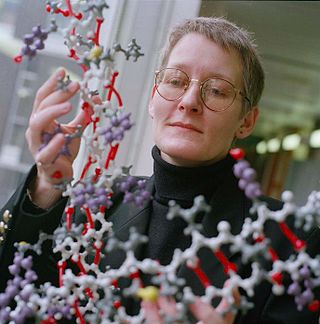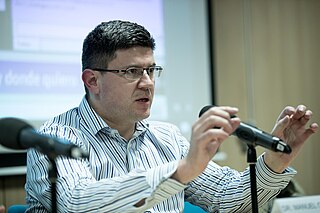In cell biology, a granule is a small particle. It can be any structure barely visible by light microscopy. The term is most often used to describe a secretory vesicle.
Open peer review is the various possible modifications of the traditional scholarly peer review process. The three most common modifications to which the term is applied are:
- Open identities: Authors and reviewers are aware of each other's identity.
- Open reports: Review reports are published alongside the relevant article.
- Open participation: The wider community are able to contribute to the review process.

The International Society for Computational Biology Student Council (ISCB-SC) is a dedicated section of the International Society for Computational Biology created in 2004. It is composed by students from all levels in the fields of bioinformatics and computational biology. The organisation promotes the development of the students' community worldwide by organizing different events including symposia, workshops, webinars, internship coordination and hackathons. A special focus is made on the development of soft skills in order to develop potential in bioinformatics and computational biology students around the world.
The Human Proteome Project (HPP) is a collaborative effort coordinated by the Human Proteome Organization. Its stated goal is to experimentally observe all of the proteins produced by the sequences translated from the human genome.

Teresa K. Attwood is a professor of Bioinformatics in the Department of Computer Science and School of Biological Sciences at the University of Manchester and a visiting fellow at the European Bioinformatics Institute (EMBL-EBI). She held a Royal Society University Research Fellowship at University College London (UCL) from 1993 to 1999 and at the University of Manchester from 1999 to 2002.

PathVisio is a free open-source pathway analysis and drawing software. It allows drawing, editing, and analyzing biological pathways. Visualization of ones experimental data on the pathways for finding relevant pathways that are over-represented in your data set is possible.

Matthew Garrett is an Irish technologist, programmer, and free software activist who is a major contributor to a series of free software projects including Linux, GNOME, Debian, Ubuntu, and Red Hat. He has received the Free Software Award from the Free Software Foundation (FSF) for his work on Secure Boot, UEFI, and the Linux kernel.
Oxford Nanopore Technologies plc is a UK-based company which develops and sells nanopore sequencing products for the direct, electronic analysis of single molecules.
Tanaka and Johnston analysis is a mixed dentition analysis which allows one to estimate the space available in an arch for the permanent teeth to erupt. This analysis was developed by Marvin M. Tanaka and Lysle E. Johnston in 1974 after they conducted a study on 506 orthodontic patients done in Cleveland at the Case Western Reserve University School of Dental Medicine.
Single-cell transcriptomics examines the gene expression level of individual cells in a given population by simultaneously measuring the RNA concentration of hundreds to thousands of genes. Single-cell transcriptomics makes it possible to unravel heterogeneous cell populations, reconstruct cellular developmental pathways, and model transcriptional dynamics — all previously masked in bulk RNA sequencing.
Statcheck is an R package designed to detect statistical errors in peer-reviewed psychology articles by searching papers for statistical results, redoing the calculations described in each paper, and comparing the two values to see if they match. It takes advantage of the fact that psychological research papers tend to report their results in accordance with the guidelines published by the American Psychological Association (APA). This leads to several disadvantages: it can only detect results reported completely and in exact accordance with the APA's guidelines, and it cannot detect statistics that are only included in tables in the paper. Another limitation is that Statcheck cannot deal with statistical corrections to test statistics, like Greenhouse–Geisser or Bonferroni corrections, which actually make tests more conservative. Some journals have begun piloting Statcheck as part of their peer review process. Statcheck is free software published under the GNU GPL v3.

Christophe Dessimoz is a Swiss National Science Foundation (SNSF) Professor at the University of Lausanne, Associate Professor at University College London and a group leader at the Swiss Institute of Bioinformatics. He was awarded the Overton Prize in 2019 for his contributions to computational biology. Starting in April 2022, he will be joint executive director of the SIB Swiss Institute of Bioinformatics, along with Ron Appel.
Vertical transmission of symbionts is the transfer of a microbial symbiont from the parent directly to the offspring. Many metazoan species carry symbiotic bacteria which play a mutualistic, commensal, or parasitic role. A symbiont is acquired by a host via horizontal, vertical, or mixed transmission.

Manuel Corpas is an Anglo-Spanish biologist and entrepreneur known primarily for his contributions to the field of Bioinformatics and Genomics. Currently Corpas is Chief Scientist of Cambridge startup Cambridge Precision Medicine, a tutor at the Institute for Continuing Education at the University of Cambridge and a lecturer at the Universidad Internacional de La Rioja. Manuel worked on the human genome from the beginning of his career, being one of the first consumers to sequence and his own genome and that of close relatives, which he published as the Corpasome. He has held positions at the Earlham Institute as Project Leader, and the Wellcome Sanger Institute, developing the DECIPHER database, a database that aids in the diagnosis of patients with rare genomic disorders.
The Carpentries is a nonprofit organization that teaches software engineering and data science skills to researchers through instructional workshops. The Carpentries is made up of three programs areas: Software Carpentry, Data Carpentry and Library Carpentry.
Adrian Gerard Barnett is a professor in the faculty of Health in the school of Public Health and Social Work, at Queensland University of Technology and was president of the Statistical Society of Australia from 2018–2020.
Multimodal cancer therapy, often referred to simply as multimodal therapy or multimodal cancer care, is an approach for treatment of cancer that combines radiation and chemotherapy or other multiple therapeutic modalities. For example, in the case of mesotheliomas, treatments combine modalities such as surgery, chemotherapy, immunotherapy, and radiotherapy. Multimodal treatments can often have synergistic effects leading to better clinical outcomes.
Krina Tynke Zondervan is a Dutch biomedical scientist who is a Professor of Genomic Epidemiology at the University of Oxford. She serves on the board of the World Endometriosis Society.
Thermotolerance is the ability of an organism to survive high temperatures. An organism's natural tolerance of heat is their basal thermotolerance. Meanwhile, acquired thermotolerance is defined as an enhanced level of thermotolerance after exposure to a heat stress.






